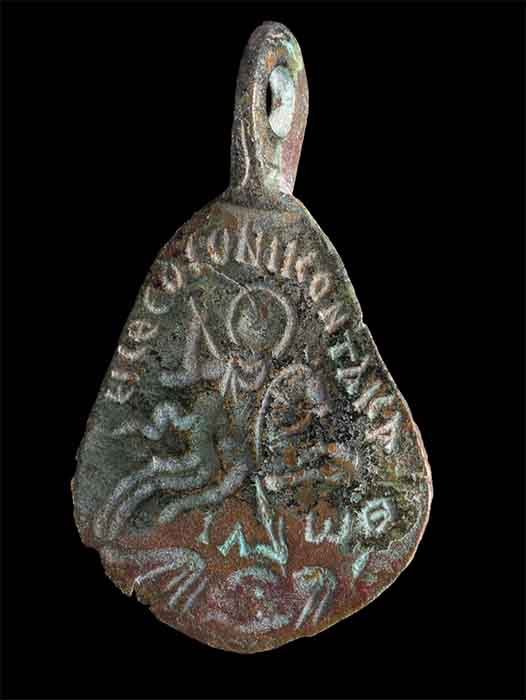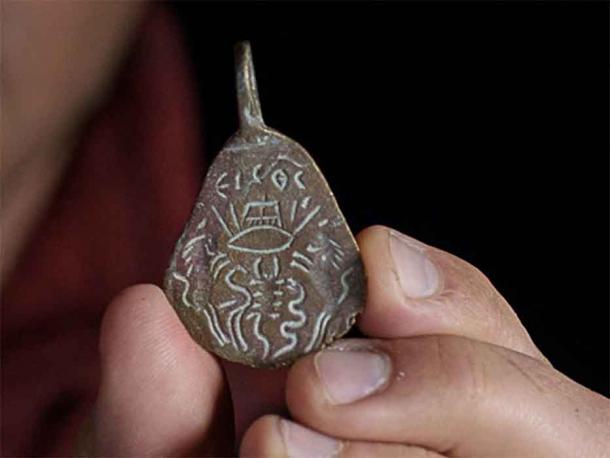A Byzantine-era amulet unearthed 40 years ago in Arbel, Israel, has been returned to the authorities. Archaeologists have calculated that the 1,500-year-old magical bronze amulet was definitely used to protect someone from the evil eye . However, whether the wearer was a pregnant Jewish woman or a member of a Gnostic cult is proving harder to answer.
The ancient Byzantine-period demon-repellent amulet was found beside the ancient Arbel moshav synagogue in northern Israel. The magical device features the four Greek letters: I A W Θ. which have led archaeologists to suspect the wearer might have been a pregnant Jewish woman trying to protect herself and her unborn baby against demons. However, there is a chance the device was owned by someone into much deeper forms of ritual magic and belonging to a mystical Palestinian Gnostic cult.

Arbel is best known for the ruins of an ancient synagogue, seen here, near to which the Byzantine amulet was unearthed. (Yael Alef / CC BY-SA 3.0 )
Byzantine Amulet Depicts Woman Being Stabbed
The Israel Antiquities Authority (IAA) has concluded that the spiritual tool of protection was created around 1,500 years ago. The Byzantine amulet has now been returned to the lower Galilee community of Arbel where it was unearthed 40 years ago by early moshav member, Tova Haviv. According to a report in Haaretz the amulet was found near the ancient synagogue of Arbel and was “belatedly turned over to the authorities by Toya’s family after her death.”
The ancient Byzantine amulet was cast in bronze. Engraved in a crescent above a holy, or saintly, horseman, is a Greek inscription: “The One God who Conquers Evil.” Below the horse’s legs are the Greek letters: I A W Θ. (IHYH) representing the divine Jewish name YHWH, or Yahweh (God). According to Haaretz, “this is a saintly figure, judging by his halo, straddling a horse, but he isn’t turning the other cheek. The saintly figure is actually stabbing a woman lying on her back with a spear.”

The bronze Byzantine-era depicts a saintly figure stabbing a woman with a holy spear. (Dafna Gazit / Israel Antiquities Authority )
Flying a Flag for “One God” in Ancient Pagan Lands
The flip side of the bronze amulet depicts an eye pierced by arrows and a pitchfork. The IAA archaeologists believe this to be a representation of the the evil eye. Furthermore, the wearers protection from demons would have been enhanced, symbolically, by the two lions, a snake, a scorpion and a bird, and the abbreviated Greek inscription for “One God,” which is essentially ancient anti-Pagan propaganda.
In the Haaretz article, Dr. Eitan Klein , deputy director of the Antiquities Theft Prevention Unit, explains that “anti-demon pendants of this type were used by everyone at the time – Jews, Christians and Gnostics.” Dr. Klein explained that the Gnostics, who were a mystical Christian cult, “believed in the war between good and evil – as did the Jewish sect at Qumran centuries earlier. In fact, general belief in that struggle was held throughout the region, from Palestine to Persia.”

The flip side of the bronze Byzantine amulet shows an eye pierced by arrows and a pitchfork. (Dafna Gazit / Israel Antiquities Authority )
Ancient Jewish Magic, or Even Older Gnostic Magic?
Amulets, seals and magic rings were all sold at cult centers. For a fee, the worried, guilty and ill informed could garner protection against demons. However, the specific type of magical amulet evidenced by the Byzantine amulet found in Arbel was worn across Palestine dating from the fifth and sixth centuries by Gnostic cults, Klein told Haaretz.
The archaeologist highlighted that it belonged to a category of magical device known as Solomon’s Seal. Klein continued to explain that the holy horse rider is shown overcoming the evil spirit, represented in this instance as the mythological female figure known as Gello or Gyllou who was believed to threaten pregnant women and their children the evil eye.
Not all such Byzantine amulets were designed for pregnant Jewish woman. Nevertheless, this particular example shows the demon as a woman, which the IAA researchers speculate indicates “a very specific in intended use.” It is thought that this bronze amulet discovered in Arbel was used to protect pregnant women and children from evil.
However, Hareetz asked an interesting question: how do the IAA know the wearer was a Jewish woman? Klein told reporters that the mention of Yahweh on the amulet doesn’t necessarily mean that the artifact was used by a Jew. Gnostic cults also worshiped the god Yahweh. Notwithstanding, the context of it’s discovery, next to a Jewish synagogue in Arbel, has led the archaeologists to suspect is was owned by a Jewish woman.
According to an article in Israel National News , although amulets are usually associated with Gnostics or Christians, Klein concluded that “the fact that the amulet was found within a Jewish settlement containing a synagogue in the fifth–sixth centuries CE may indicate that even Jews of the period wore amulets of this type for protection against the evil eye and demons.”
Top image: Dr. Eitan Klein, Archeologist and Deputy Director of the Antiquities Theft Prevention Unit for Israel Antiquities Authority, holding the Byzantine-amulet under investigation. Source: Dafna Gazit / Israel Antiquities Authority
By Ashley Cowie
Related posts:
Views: 0
 RSS Feed
RSS Feed















 May 27th, 2021
May 27th, 2021  Awake Goy
Awake Goy  Posted in
Posted in  Tags:
Tags: 
















